Jeff Way Masters Geometrical Lines, Grids, and Abstraction in ‘Then & Now’
The exhibition is on view until October 5 at Storage Gallery at 52 Walker St.
Image Courtesy of Storage Gallery
In the midst of New York Fashion Week, I took a much-needed break from the chaos of the lines and the runway shows. Nestled in the heart of Tribeca and up five flights of stairs is the legendary Jeff Way’s long-time studio and home. It holds works by Ohio-born artist dating back to the 1960s.
As I walked up the five flights of stairs, I was overwhelmed with art covering every inch of the space from floor to ceiling. Whether it was made by Way himself or a piece was given to him by a fellow artist, you could fill many museums with just the works in his home studio. It didn’t take me long to notice the dozens of masks on his towering wall. Made with rigid wrap, plaster, gauze for casting forms, oil paint, and even old aluminum takeout boxes, Happy Zombies were pressed against Way’s face and added with layers over the years and then mounted on his wall.
Using almost every drawing and painting technique in artistry, Way is acclaimed for his chalk line grid paintings. He makes them with a carpenter’s chalk tool filled with powdered pigments. He then snaps the line across the canvas, creating nearly perfect grid lines with a do-it-yourself yardstick with nails. Much of this work, as well as his abstract pieces, are now on view at Storage Gallery at 52 Walker St. until October 5. Then & Now displays Way’s work from 1970 to 2024, showing the striking contrast of flatness and depth on his canvases.
Weirdly enough, as Way showed me some of his older grid pencil drawings, I began to have a seizure on his paint-splattered wood floor. He and his wife, Carolyn, did everything to make sure I was okay, and all I could think about was if I was going to remember such a memorable space filled with so much history. Luckily, I did, and when it happened, he described it as “the biggest reaction anyone has ever had to my art.” Continue reading as 1202 MAGAZINE had the opportunity to chat with the iconic Way about his art styles, processes, and exhibition, Then & Now, at Storage Gallery.
Hi Jeff! Congratulations, and thanks for taking the time to answer these questions. Could you tell me a bit about the meaning and purpose behind this exhibition on view at Storage and what viewers can expect to see?
The exhibition spans two key periods in my practice: The Chalk Line Paintings from 1969 to 1973, just after finishing graduate school at NYU, and the body of work, which I refer to as the Eccentric Squares. For the chalk line paintings, I used a carpenter's chalk line tool loaded with powdered pigments. I’d snap the line across a canvas placed horizontally, creating various pigment patterns, sometimes resembling soundwaves. I created this device using nails and a yardstick to ensure precision in lining up these marks, allowing for controlled yet expressive results.
I had read this book on Chinese painting and one passage really stuck with me–the art of painting consists of four main characters, horizontal and vertical, combining and scattering. This is what is meant by yin yang, which constitutes the Tao, and I thought that was kind of profound, and it really related directly to what I was doing in my painting practice. During this time, process-driven work was prevalent; artists like Richard Serra and Jackson Pollock used materials in ways that allowed the outcome to emerge from the act itself. This concept inspired me to explore the chalk line as a tool for creating art.
The current exhibition, titled Then & Now, shows both the early chalk line works and recent paintings from my Eccentric Squares series. In 2015, I returned to the chalk line works when my daughter asked if I had a white painting for her wedding. One of the pieces in the show is the actual painting from the ceremony. Revisiting the chalkline method after 40 years brought back the physical challenges of working with powdered pigments, but it also reignited my interest in this form. I began exploring variations, like working with grids and eccentric squares, which led to new drawings and, eventually, paintings.
In the show, viewers can expect to see a range of work, from large atmospheric paintings that involve casting and layering pigment to more structured, grid-based pieces. One notable early work is a 7x12 foot painting that uses horizontal lines and a richly built-up surface through a process of throwing and spraying pigment, allowing for a dynamic interaction of colors and textures. This painting, created between 1969 and 1970, marks a transition in my studio practice and serves as a grounding painting for the show.
What do your works, such as Eccentric Squares, Chalk Line Paintings, and Chief with Cherries, represent?
As I mentioned, I used the chalk line as a central tool, but my approach to the paintings varied. I started using the grid and different colors for the lines, some of which I went over multiple times to create a fuzzy effect. From there, I moved to more horizontal works, focusing on how the pigment created layers and surface textures. These paintings often involved 4-6 colors interacting with each other. I also did black-and-white works, followed by primary color paintings, and then a red, yellow, and green one called Dragon Painting, where the grid moved in and out of color areas.
The Dragon Painting marked the end of the chalkline series. I transitioned to oil painting with a brush due to health concerns, as I knew artists who faced serious health issues from working with similarly toxic materials. Around the same time, I revisited my longstanding interest in Native American culture and began creating collages, including Chief with Cherries. I took an image of a Native American from a photo book, added decals of cherries, and started distributing copies to friends, asking them to modify one and return it. Over time, the project grew, and I ended up showing 60 of these works alongside 90 from other artists, including Ray Johnson, in a 1974 Whitney exhibition curated by Elka Solomon.
My abstract work was heavily influenced by Rothko and Color Field painting, but I was also drawn to Dada and Surrealist collage. For a while, I focused solely on abstract painting, but Chief with Cherries became a parallel project. It was a "closet art project" that evolved over time and led to a shift in my practice.
By the late 70s, I began exploring different mediums like masks, performance art, and self-portraits. The self-portraits, often depicting myself holding snakes, reflected my childhood fears and nightmares. These drawings were unrefined, contrasting with my abstract work, but they carried a certain energy. Some people who had supported my abstract painting didn’t understand the shift, but I continued to expand my practice.
Eventually, I realized I needed to give myself permission to respond to events and pursue what felt necessary. This period of exploration led to recognition, with exhibitions at Pam Adler Gallery and reviews in major art publications like Art in America, Artforum, and The Village Voice.
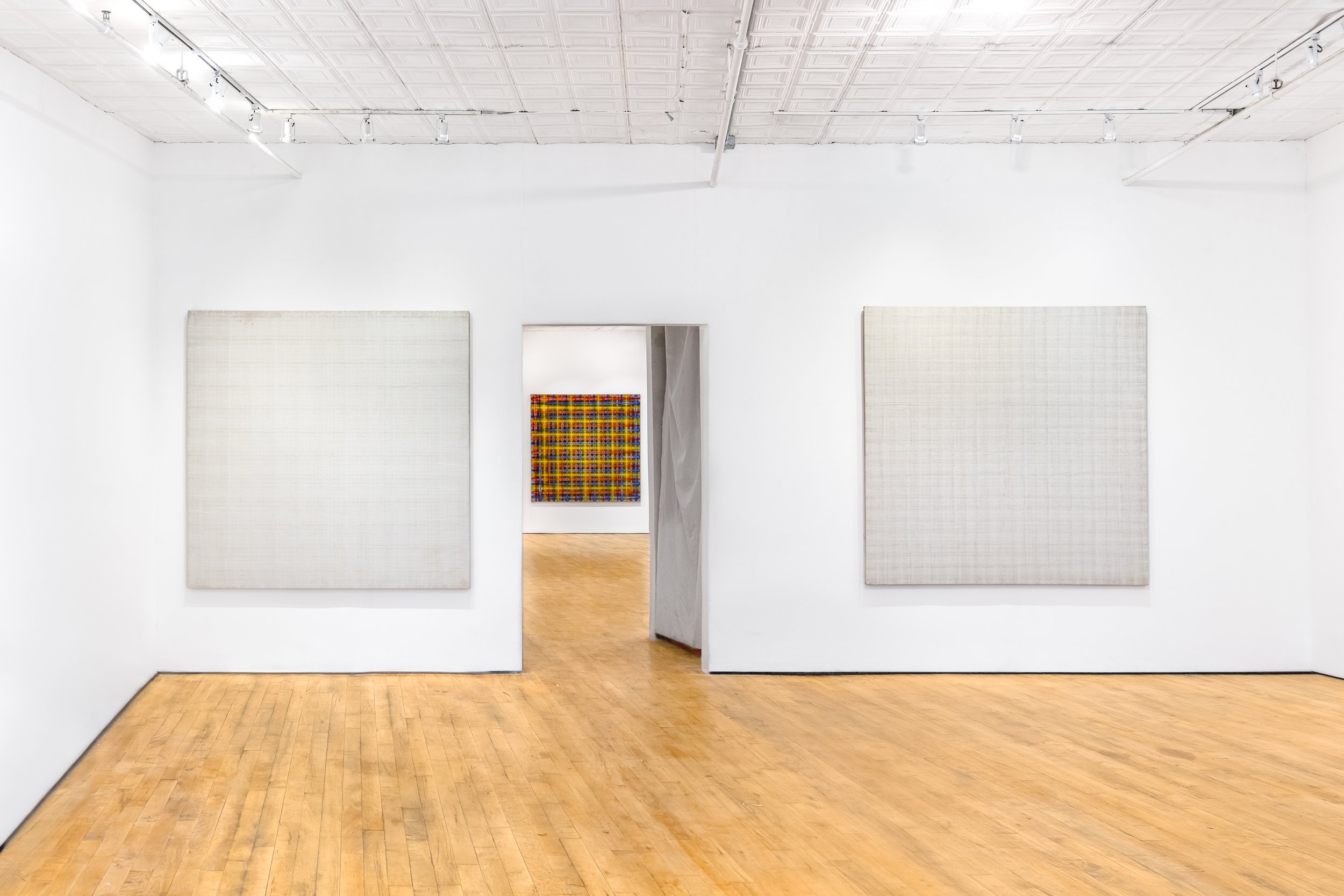
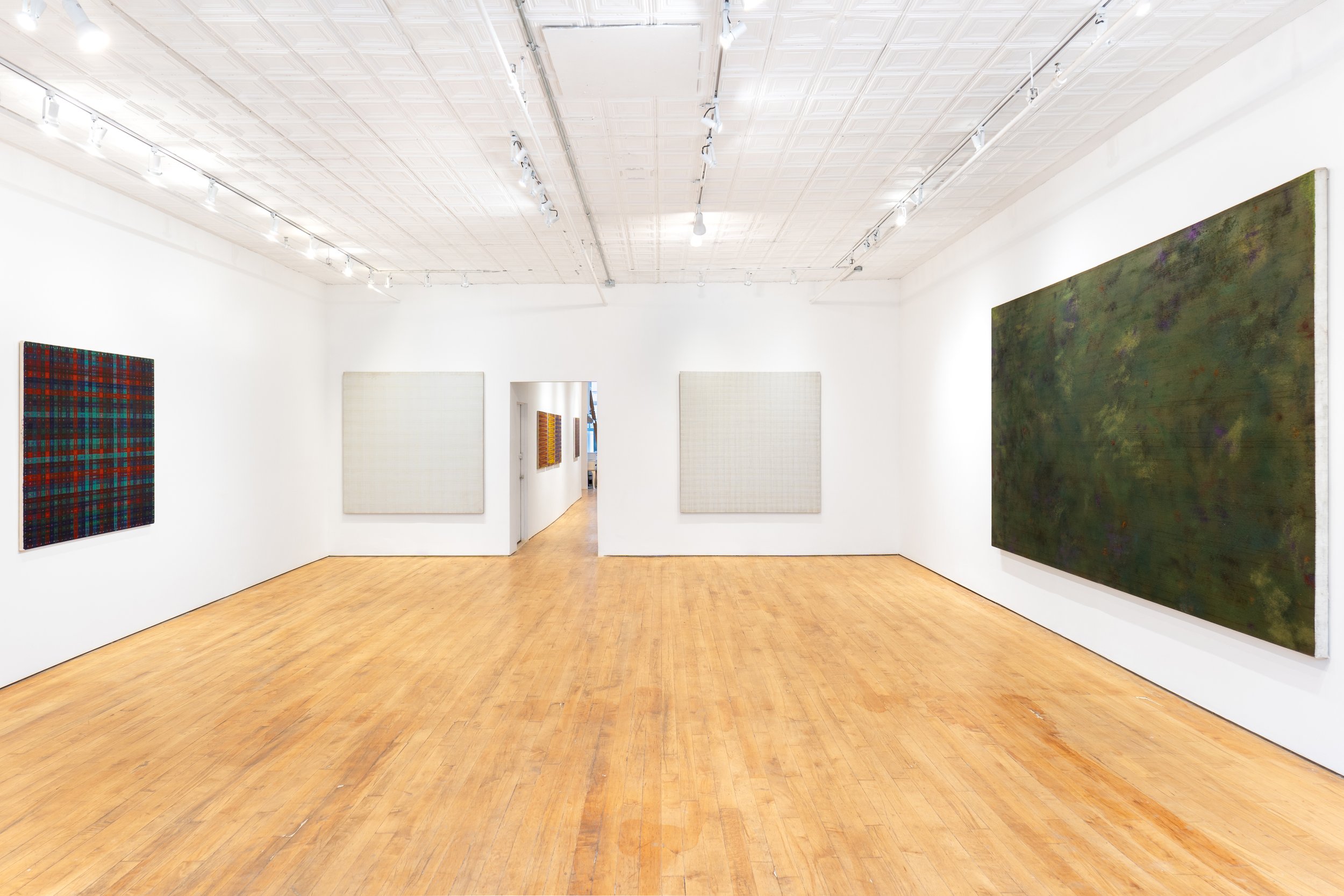
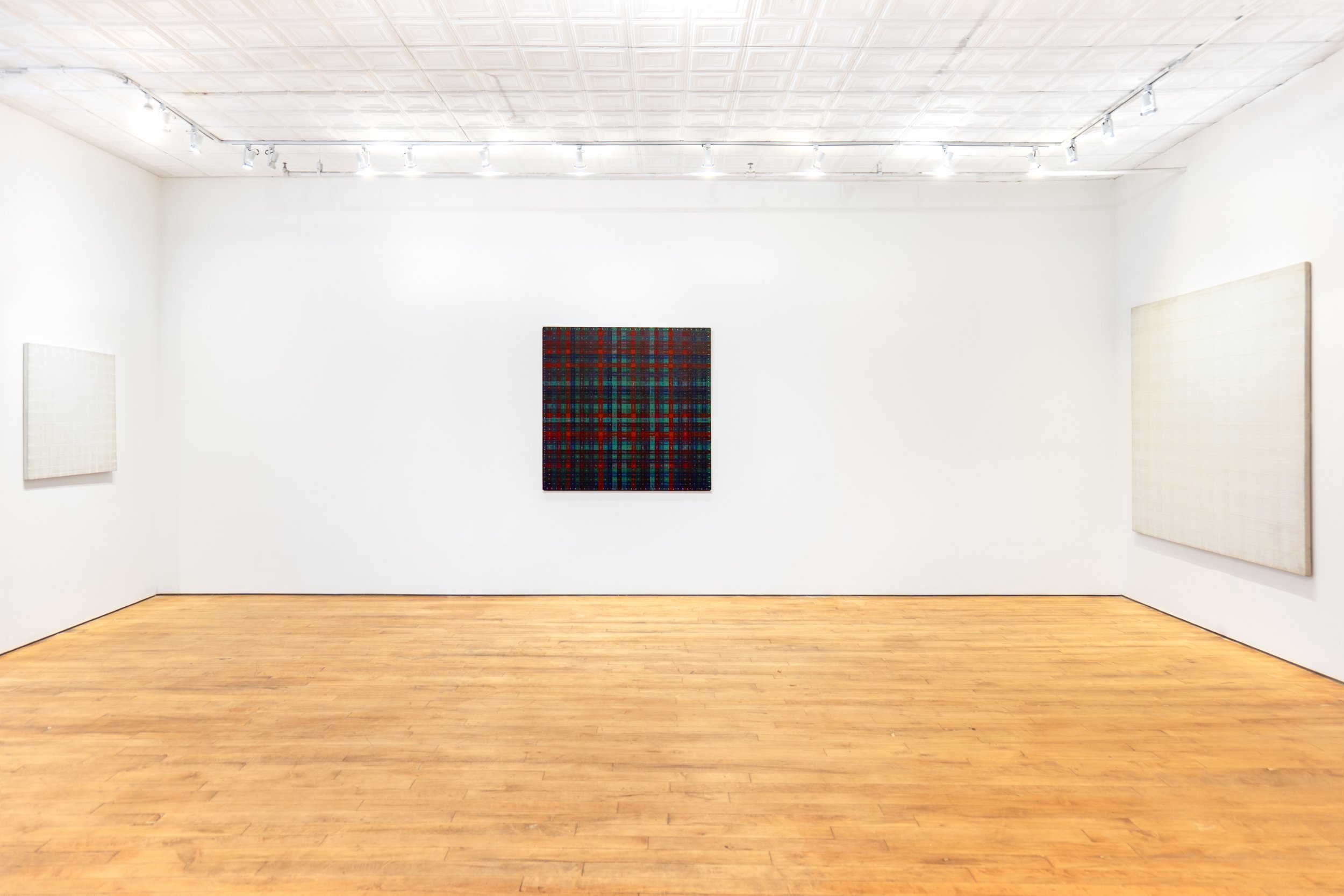

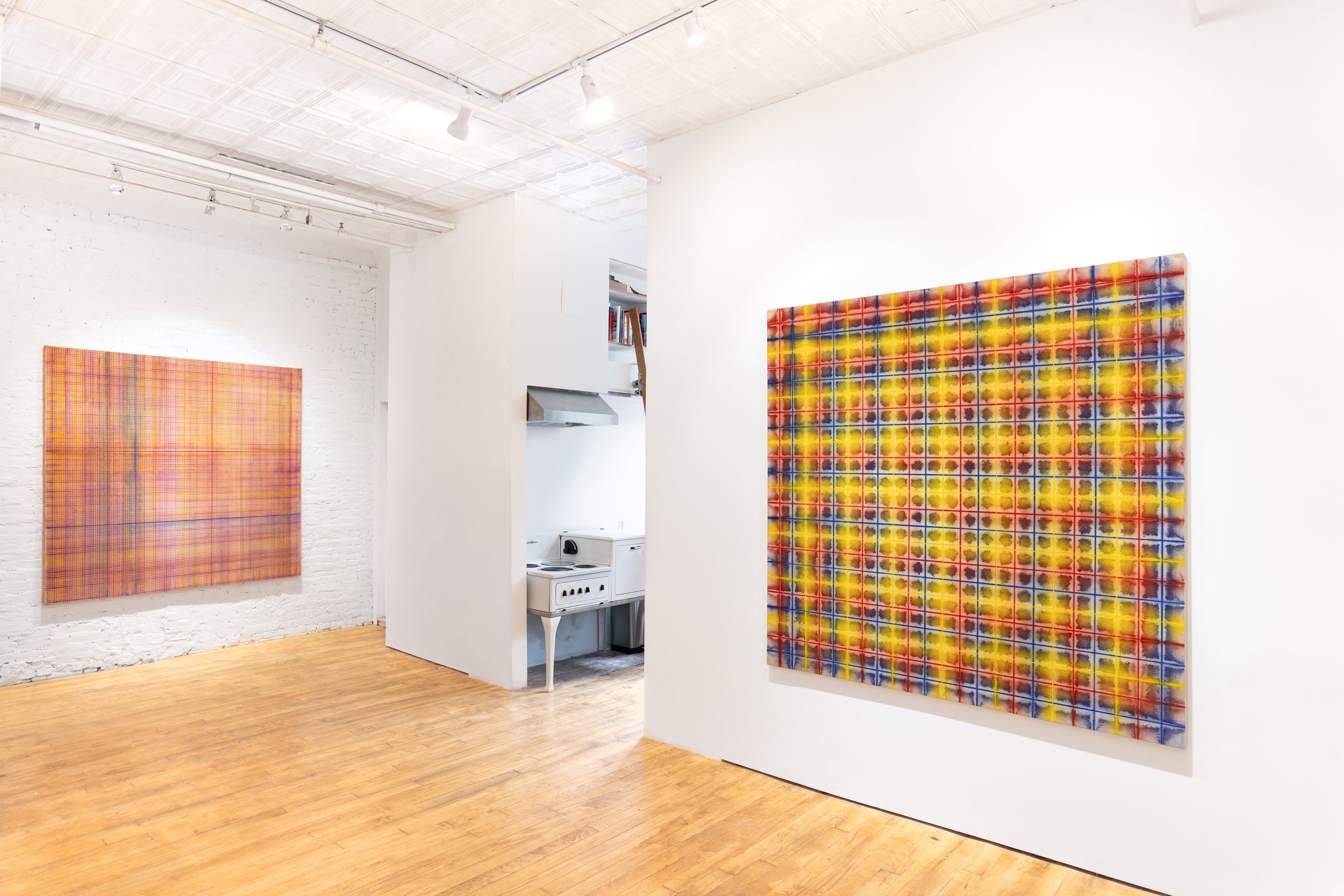
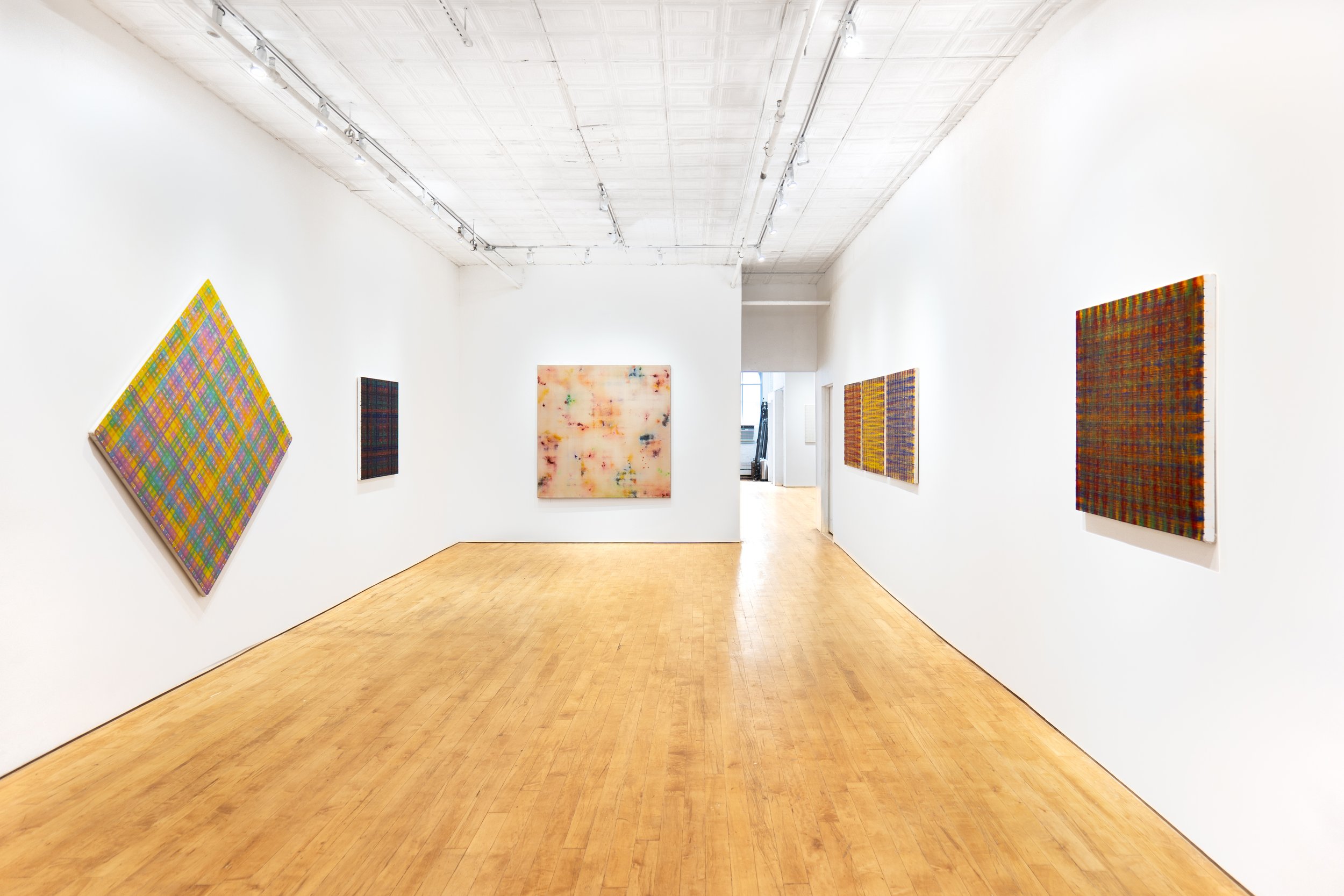
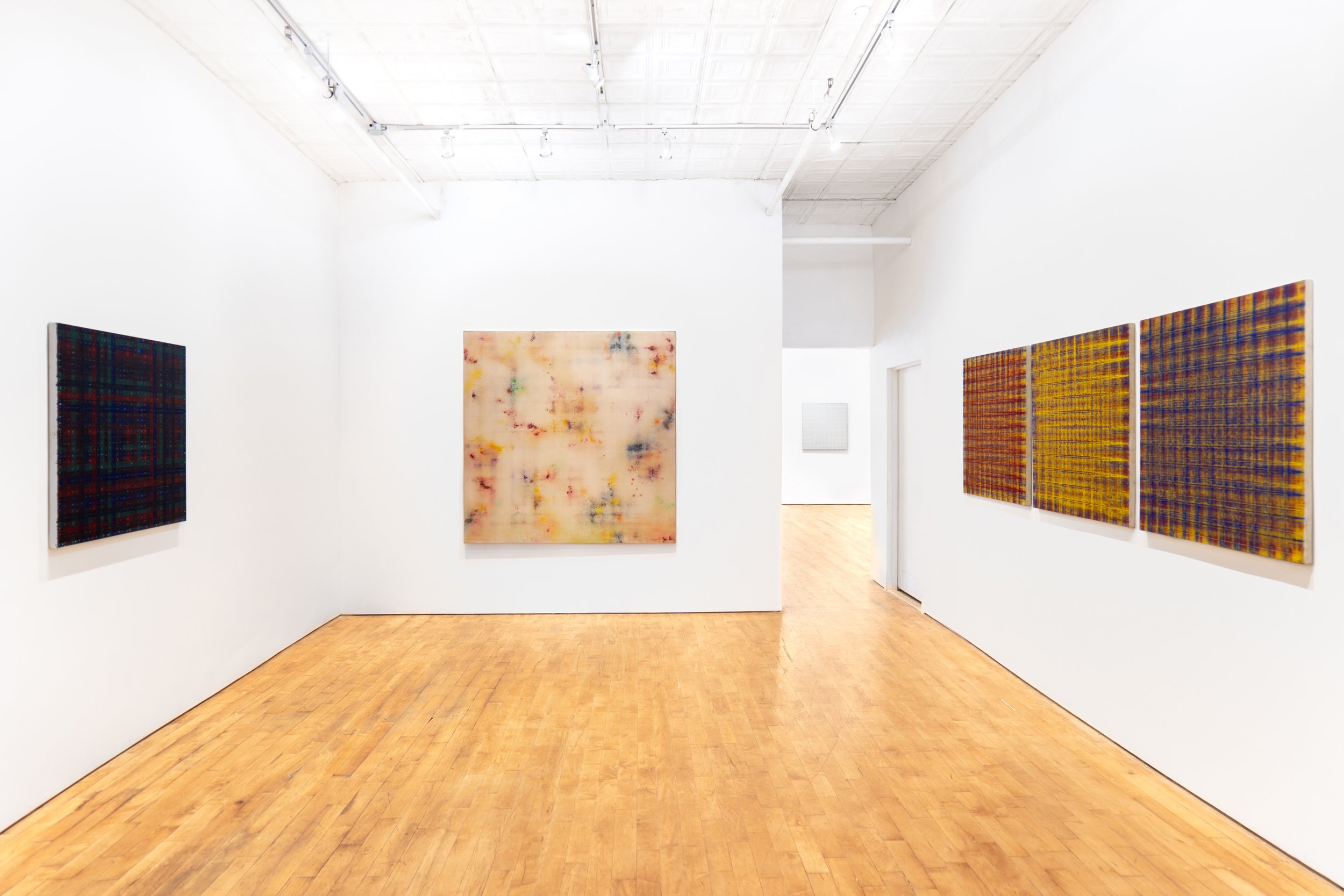
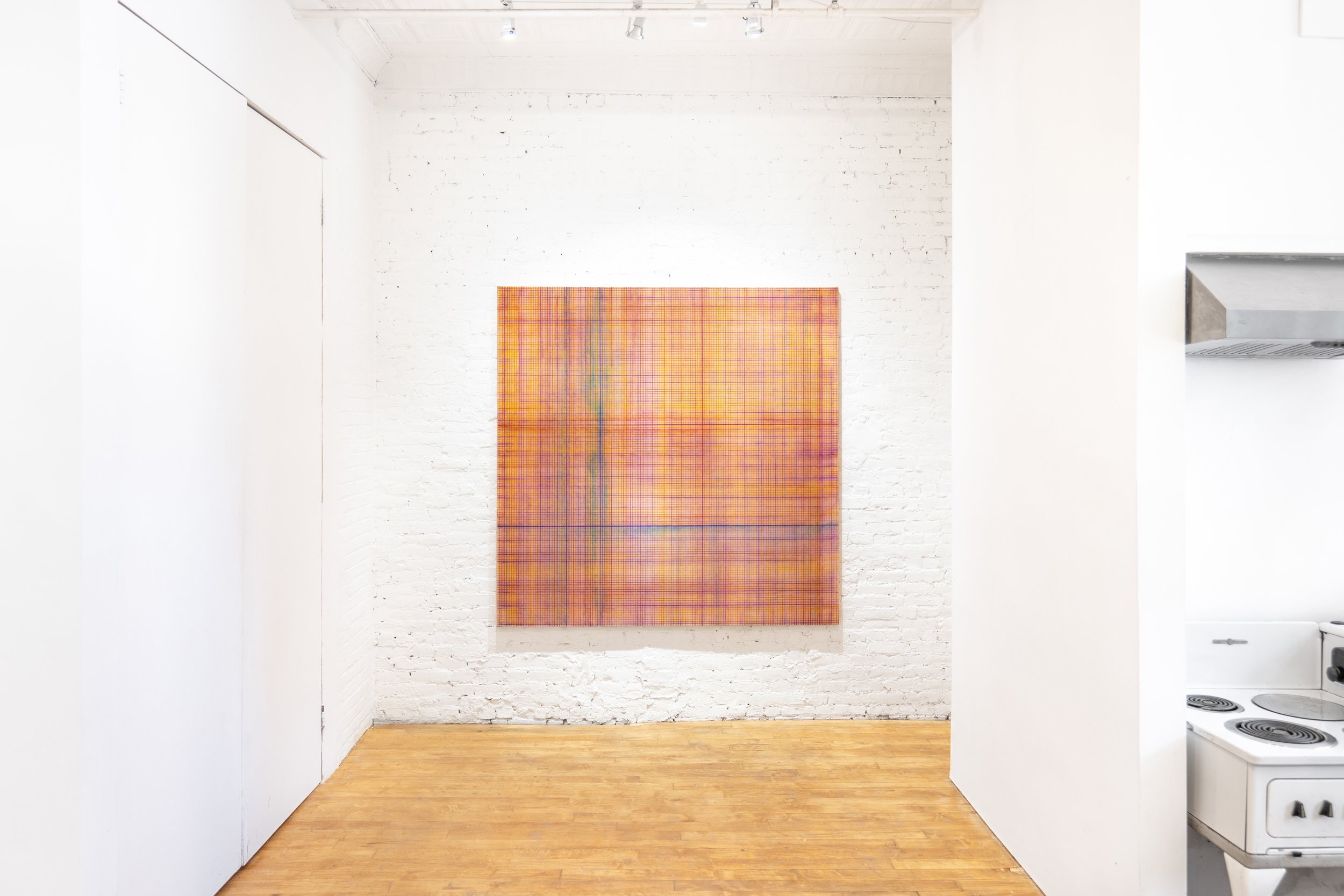
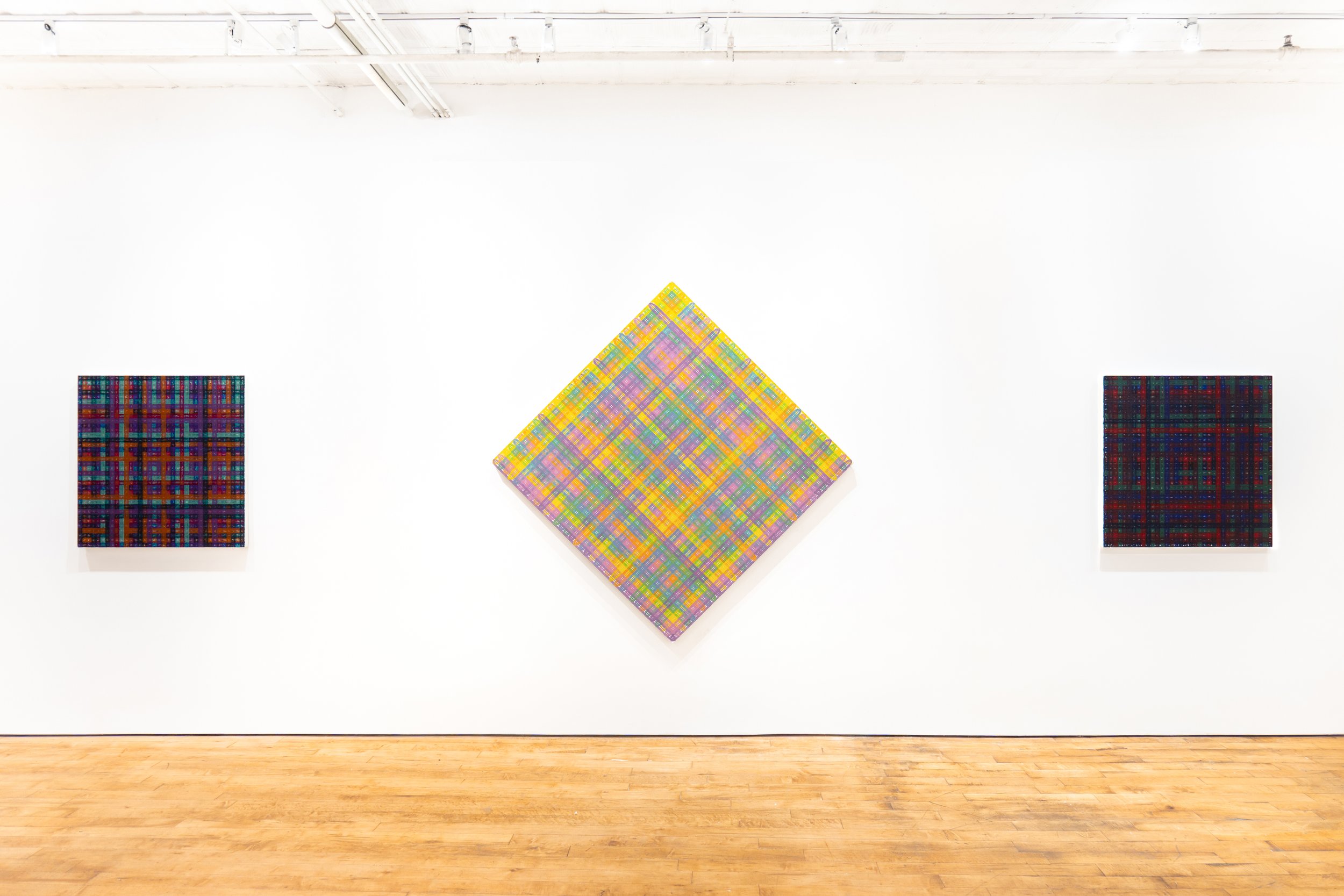

Image Courtesy of Storage Gallery
What does your creative process look like emotionally, physically, and mentally?
At a certain point, I gave myself permission to create freely, whether making masks, paintings, drawings, or even doing performances. My process is about responding to whatever comes up in life, like the story of my daughter's wedding, which led me to revisit old works. In the studio, I'm a bit messy—not quite Francis Bacon-level, but things accumulate. Sometimes, new ideas come from sifting through old materials. I prefer to stay open to possibilities rather than having a narrow focus.
The work I’m doing now, Eccentric Squares, is quite elemental. It involves creating precise lines with masking tape and building up layers of repetitive brush marks. Though it seems simple, the way the lines and layers interact adds complexity. The exposed bits of canvas also add a shimmering effect that creates visual interest.
As for my masks, I work with a variety of materials, often using Rigid Wrap, plaster, and gauze for casting forms, but I also work with found materials. For example, I used to mix oil paints in takeout containers. Over time, they built up layers, and I couldn’t bring myself to throw them away. I started pressing them against my face to create a series titled Happy Zombies. I was also drawn to shamanism, particularly influenced by Joseph Beuys. His idea of the artist as a shaman resonated with me, and that became a key theme in my work, particularly in terms of my performance piece, Transformations.
You've been painting for decades. When was the last time you painted, and how do you think you've evolved since you first began painting?
I painted just a few days ago. We have a place in Saugerties, where I have a studio. I’ve been working on a painting from the Eccentric Squares series, but right now, my focus is on the exhibition. Once I’m back upstate, I’ll continue working on it.
These paintings take time. Lately, I’ve been turning some on the diagonal, making them diamond-shaped. Whether a painting works better as a square or a diamond usually becomes clear later in the process. I first experimented with this diamond shape in my last semester of graduate school and continued when I was painting in Georgia. After I returned to New York, I got inspired by Marcia Tucker's Whitney show, Anti-Illusion: Procedures/Materials, and started the chalkline series. One of the first paintings from that series is in the exhibition now—it’s been a long time, and I’d almost forgotten about it, but seeing it again makes sense.
I would love to hear more about your background and life story. When did you start painting, and what inspired you to start? What was your life like before you began making art?
I started painting in college. As a kid, I loved coloring, but in high school, I focused more on sports, especially football. It wasn’t until my junior year at Kenyon College, a small school with 600 students, that I took a painting class. There wasn’t an art department, but a new instructor came and taught painting and art history. I ended up auditing the class. The art studios were in a tower, which made the whole experience feel kind of romantic.
Later, I took an art history class because I was a history major. I decided to combine my interests and apply to graduate school for art history despite having only one semester of art history. I got into NYU in 1964 and moved to New York. However, I hit a wall with my scholarship, and the idea of writing a thesis on Rothko and Still overwhelmed me. I met Rothko during my research thanks to my thesis advisor, Robert Goldwater, who arranged an interview.
After leaving NYU, I eventually realized I was actually better off in school and reapplied to their studio program. I worked at the Guggenheim and Marlborough Gallery while I was studying, which exposed me to incredible art and artists. One day, I had to take a Rothko painting on paper from the gallery to his studio. He recognized me from our previous meeting and asked how my thesis was going. When I told him I’d dropped out to become a painter, he invited me into his studio, where he was working on the Rothko Chapel. It was an unforgettable experience.
That summer, I took a painting class at the New School, working mostly from a model. I used some of that work in my portfolio when applying to NYU’s studio program. My portfolio was pretty underwhelming, but the interviewer was impressed by my background at the Institute of Fine Arts and my Woodrow Wilson Fellowship. He decided to give me a chance. He let me take freshman classes, and that’s how my journey in painting began.
Do you still paint? If so, how long can you see yourself continuing? If not, why did you stop?
I’ll keep painting as long as I can hold a brush. The great thing about being an artist is that you don’t retire from it—it’s a way of life. I feel very fortunate to have been doing this for over 50 years and to still be able to continue. My health is good, and I’ve still got most of my marbles, so I plan to carry on for a while.
Could you tell me about your beloved Tribeca studio? Is that where your inspiration blooms? If not, where do you usually draw inspiration from?
I’ve been in Tribeca since 1969 and have had three different studios. The first was on Greenwich Street. Then, I moved to Leonard Street, which was torn down to build a law school. In 1975, I got the space on Walker Street and moved in by 1976. The space was completely raw—no gas, water, or electricity above the second floor. My partner, a sculptor with building skills, and I renovated it ourselves, with some help from others. At the time, everything was illegal, and we had to keep a low profile and occasionally pay off inspectors to get gas and electricity.
Originally, I envisioned a clean, pristine space, but I fell in love with the industrial features like the hoist wheel that goes down to the ground floor. The front part of the studio has the original funky wooden floors, while the rest has sub-flooring.
Inspiration comes from everywhere, especially the space itself. The burnt wall, for instance, has influenced my mask work. The key for me is to stay open to possibilities. Early in my career, I focused on abstract painting as “serious art,” but I realized I was limiting myself. Experiences like working on the Cherry series helped me embrace whatever I felt compelled to explore, and that openness has been essential to my process.
Are there any art styles or techniques you've never tried that you want to experiment with?
I can’t think of any specific techniques I haven’t tried, but I’m always open to new ideas. Right now, I’m deeply involved in my current work, but my practice has evolved over the years. Much of my earlier work was “image-based,” drawing from art history and popular culture.
For example, I did a series of “composite heads” using collage, where I combined images of the same person at different times or different people together. It started with Kurt Schwitters, a collage artist, and I created black-and-white paintings based on a series of photo portraits of him. Those pieces were shown at a gallery in the ‘70s called Carl Solway. Later, I did a series called Bebop Bauhaus Heads, where I combined different styles and used plexiglass for transparency, letting light pass through the painting.
In the ‘70s, I began working in oil, then switched to acrylic later in the ‘80s. I did a series on Elvis, as well as a show called Elvis and Jesus, where I painted grids of heads, combining reproductions of historical images of Jesus into new configurations. These pieces had a cross formation in the center, creating two distinct bodies of work.
So, there has been quite an evolution. As I said, I’m deeply engaged with my current work, but I remain open to whatever new ideas come my way.
What are some of your goals in terms of your art and personal journeys?
In terms of my art, this exhibition is a big step in reactivating my career. I had a show in 2019 just before the pandemic, but the gallery closed, and my work was at a transition point between more image-based heads and grids and the chalk line paintings I’ve been developing. Onyedika really connected with my work, and I’m excited to see where things go—especially with Artforum listing the show as a must-see.
As for goals, I’d love to increase my sales and get my work out there more. There have been periods of success and quiet, but I’ve always kept working, making masks and other pieces consistently. Personally, I aim to stay open to possibilities, which has been key throughout my journey. So far, I’ve managed to do that, and I’m excited for what’s next. We’ll see how it goes.

